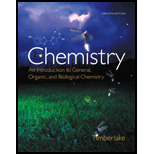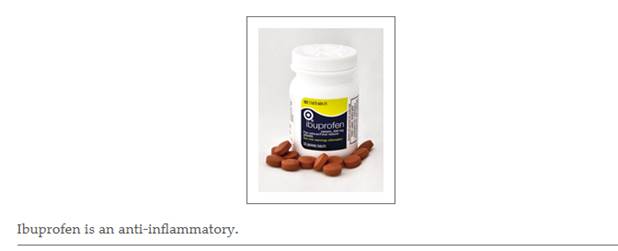
Chemistry: An Introduction to General, Organic, and Biological Chemistry (12th Edition) - Standalone book
12th Edition
ISBN: 9780321908445
Author: Karen C. Timberlake
Publisher: PEARSON
expand_more
expand_more
format_list_bulleted
Concept explainers
Textbook Question
Chapter 7, Problem 7.74UTC
Ibuprofen, an anti-inflammatory drug in Advil, has the formula

a. What is the molar mass of ibuprofen?
b. How many grams of ibuprofen are in 0.525 mole?
c. How many moles of C are in 12.0 g of ibuprofen?
d. How many moles of ibuprofen contain
Expert Solution & Answer
Trending nowThis is a popular solution!

Students have asked these similar questions
5.
Use the MS data to answer the questions on the next page.
14.0
1.4
15.0
8.1
100-
MS-IW-5644
26.0
2.8
27.0
6.7
28.0
1.8
29.0
80
4.4
38.0
1.0
39.0
1.5
41.0
1.2
42.0
11.2
43.0
100.0
44.0
4.3
79.0
1.9
80.0
2.6
Relative Intensity
40
81.0
1.9
82.0
2.5
93.0
8.7
20-
95.0
8.2
121.0
2.0
123.0
2.0
136.0
11.8
0
138.0
11.5
20
40
8.
60
a.
Br
- 0
80
100
120
140
160
180
200
220
m/z
Identify the m/z of the base peak and molecular ion.
2
b.
Draw structures for each of the following fragments (include electrons and charges): 43.0, 93.0,
95.0, 136.0, and 138.0 m/z.
C.
Draw a reasonable a-fragmentation mechanism for the fragmentation of the molecular ion to
fragment 43.0 m/z. Be sure to include all electrons and formal charges.
6. Using the values provided in Appendix E of your lab manual, calculate the monoisotopic mass for the pyridinium
ion (CsH6N) and show your work.
None
Stereochemistry: Three possible answers- diastereomers, enantiomers
OH
CH₂OH
I
-c=0
21108 1101
41745 HOR
CH₂OH
IL
Но
CH₂OH
TIL
a. Compounds I and III have this relationship with each other: enantiomers
b. Compounds II and IV have this relationship with each other:
c. Compounds I and II have this relationship with each other:
d. *Draw one structure that is a stereoisomer of II, but neither a
diastereomer nor an enantiomer. (more than one correct answer)
Chapter 7 Solutions
Chemistry: An Introduction to General, Organic, and Biological Chemistry (12th Edition) - Standalone book
Ch. 7.1 - What is a mole?Ch. 7.1 - What is Avogadro’s number?Ch. 7.1 - Calculate each of the following: a. number of C...Ch. 7.1 - Calculate each of the following: a. number of Li...Ch. 7.1 - Calculate each of the following quantities in 200...Ch. 7.1 - Calculate each of the following quantities in...Ch. 7.1 - Prob. 7.7QAPCh. 7.1 - Aluminum sulphate, Al2SO43 , is used in some...Ch. 7.2 - Prob. 7.9QAPCh. 7.2 - Prob. 7.10QAP
Ch. 7.2 - Prob. 7.11QAPCh. 7.2 - Prob. 7.12QAPCh. 7.2 - Prob. 7.13QAPCh. 7.2 - Prob. 7.14QAPCh. 7.2 - Prob. 7.15QAPCh. 7.2 - Prob. 7.16QAPCh. 7.2 - Prob. 7.17QAPCh. 7.2 - Prob. 7.18QAPCh. 7.2 - Prob. 7.19QAPCh. 7.2 - Prob. 7.20QAPCh. 7.2 - Prob. 7.21QAPCh. 7.2 - Prob. 7.22QAPCh. 7.2 - Prob. 7.23QAPCh. 7.2 - Prob. 7.24QAPCh. 7.2 - Prob. 7.25QAPCh. 7.2 - Prob. 7.26QAPCh. 7.3 - Determine whether each of the following chemical...Ch. 7.3 - Determine whether each of the following chemical...Ch. 7.3 - Balance each of the following chemical equations:...Ch. 7.3 - Balance each of the following chemical equations:...Ch. 7.3 - Balance each of the following chemical equations:...Ch. 7.3 - Balance each of the following chemical equations:...Ch. 7.4 - Prob. 7.33QAPCh. 7.4 - Prob. 7.34QAPCh. 7.4 - Prob. 7.35QAPCh. 7.4 - Prob. 7.36QAPCh. 7.4 - Prob. 7.37QAPCh. 7.4 - Prob. 7.38QAPCh. 7.5 - Prob. 7.39QAPCh. 7.5 - Prob. 7.40QAPCh. 7.5 - In each of the following, identify the reactant...Ch. 7.5 - In each of the following, identify the reactant...Ch. 7.5 - Prob. 7.43QAPCh. 7.5 - Prob. 7.44QAPCh. 7.5 - Prob. 7.45QAPCh. 7.5 - Prob. 7.46QAPCh. 7.6 - Write all of the mole—mole factors for each of the...Ch. 7.6 - Write all of the mole—mole factors for each of the...Ch. 7.6 - The chemical reaction of hydrogen with oxygen...Ch. 7.6 - Prob. 7.50QAPCh. 7.6 - Carbon disulfide and carbon monoxide are produced...Ch. 7.6 - Prob. 7.52QAPCh. 7.7 - Sodium reacts with oxygen to produce sodium oxide....Ch. 7.7 - Nitrogen gas reacts with hydrogen gas to produce...Ch. 7.7 - Ammonia and oxygen react to form nitrogen and...Ch. 7.7 - Iron(III) oxide reacts with carbon to give iron...Ch. 7.7 - Nitrogen dioxide and water react to produce nitric...Ch. 7.7 - Calcium cyanamide, CaCN2 , reads with water to...Ch. 7.7 - Prob. 7.59QAPCh. 7.7 - When the gases dihydrogen sulfide and oxygen...Ch. 7.8 - Prob. 7.61QAPCh. 7.8 - Prob. 7.62QAPCh. 7.8 - Classify each of the following as exothermic or...Ch. 7.8 - Classify each of the following as exothermic or...Ch. 7.8 - Classify each of the following as exothermic or...Ch. 7.8 - Classify each of the following as exothermic or...Ch. 7.8 - a. What is meant by the rate of a reaction? b. Why...Ch. 7.8 - a. How does a catalyst affect the activation...Ch. 7.8 - Prob. 7.69QAPCh. 7.8 - How would each of the following change the rate of...Ch. 7 - Prob. 7.71UTCCh. 7 - Using the models of the molecules (black = C,...Ch. 7 - A dandruff shampoo contains dipyrithione,...Ch. 7 - Ibuprofen, an anti-inflammatory drug in Advil, has...Ch. 7 - Prob. 7.75UTCCh. 7 - Balance each of the following by adding...Ch. 7 - Prob. 7.77UTCCh. 7 - Prob. 7.78UTCCh. 7 - If blue spheres represent nitrogen atoms, purple...Ch. 7 - Prob. 7.80UTCCh. 7 - Prob. 7.81UTCCh. 7 - Prob. 7.82UTCCh. 7 - Calculate the molar mass for each of the...Ch. 7 - Calculate the molar mass for each of the...Ch. 7 - How many grams are in 0.150 mole of each of the...Ch. 7 - How many grams are in 2.25 moles of each of the...Ch. 7 - How many moles are in 25.0 g of each of the...Ch. 7 - How many moles are in 4.00 g of each of the...Ch. 7 - Identify the type of reaction for each of the...Ch. 7 - Identify the type of reaction for each of the...Ch. 7 - Prob. 7.91AQAPCh. 7 - Prob. 7.92AQAPCh. 7 - Prob. 7.93AQAPCh. 7 - Prob. 7.94AQAPCh. 7 - Identify each of the following as an oxidation or...Ch. 7 - Prob. 7.96AQAPCh. 7 - When ammonia NH3 gas reacts with fluorine gas, the...Ch. 7 - When nitrogen dioxide NO2 gas from car exhaust...Ch. 7 - Pentane gas, C5H12 undergoes combustion with...Ch. 7 - Prob. 7.100AQAPCh. 7 - Prob. 7.101AQAPCh. 7 - The equation for the formation of nitrogen oxide...Ch. 7 - Prob. 7.103CQCh. 7 - Prob. 7.104CQCh. 7 - Prob. 7.105CQCh. 7 - A toothpaste contains 0.240% by mass sodium...Ch. 7 - Prob. 7.107CQCh. 7 - Prob. 7.108CQCh. 7 - Prob. 7.109CQCh. 7 - Prob. 7.110CQ
Knowledge Booster
Learn more about
Need a deep-dive on the concept behind this application? Look no further. Learn more about this topic, chemistry and related others by exploring similar questions and additional content below.Similar questions
- Don't used Ai solutionarrow_forwardDon't used Ai solutionarrow_forwardIn mass spectrometry, alpha cleavages are common in molecules with heteroatoms. Draw the two daughter ions that would be observed in the mass spectrum resulting from an alpha cleavage of this molecule. + NH2 Q Draw Fragment with m/z of 72arrow_forward
- Write the systematic (IUPAC) name for each of the following organic molecules: F structure Br LL Br Br الحمد name ☐ ☐arrow_forwardDraw an appropriate reactant on the left-hand side of this organic reaction. Also, if any additional major products will be formed, add them to the right-hand side of the reaction. + + Х ง C 1. MCPBA Click and drag to start drawing a structure. 2. NaOH, H₂O Explanation Check OI... OH ol OH 18 Ar © 2025 McGraw Hill LLC. All Rights Reserved. Terms of Use | Privacy Center | Accessibilityarrow_forwardCalculate the atomic packing factor of quartz, knowing that the number of Si atoms per cm3 is 2.66·1022 and that the atomic radii of silicon and oxygen are, respectively, 0.038 and 0.117 nm.arrow_forward
arrow_back_ios
SEE MORE QUESTIONS
arrow_forward_ios
Recommended textbooks for you
 ChemistryChemistryISBN:9781305957404Author:Steven S. Zumdahl, Susan A. Zumdahl, Donald J. DeCostePublisher:Cengage Learning
ChemistryChemistryISBN:9781305957404Author:Steven S. Zumdahl, Susan A. Zumdahl, Donald J. DeCostePublisher:Cengage Learning ChemistryChemistryISBN:9781259911156Author:Raymond Chang Dr., Jason Overby ProfessorPublisher:McGraw-Hill Education
ChemistryChemistryISBN:9781259911156Author:Raymond Chang Dr., Jason Overby ProfessorPublisher:McGraw-Hill Education Principles of Instrumental AnalysisChemistryISBN:9781305577213Author:Douglas A. Skoog, F. James Holler, Stanley R. CrouchPublisher:Cengage Learning
Principles of Instrumental AnalysisChemistryISBN:9781305577213Author:Douglas A. Skoog, F. James Holler, Stanley R. CrouchPublisher:Cengage Learning Organic ChemistryChemistryISBN:9780078021558Author:Janice Gorzynski Smith Dr.Publisher:McGraw-Hill Education
Organic ChemistryChemistryISBN:9780078021558Author:Janice Gorzynski Smith Dr.Publisher:McGraw-Hill Education Chemistry: Principles and ReactionsChemistryISBN:9781305079373Author:William L. Masterton, Cecile N. HurleyPublisher:Cengage Learning
Chemistry: Principles and ReactionsChemistryISBN:9781305079373Author:William L. Masterton, Cecile N. HurleyPublisher:Cengage Learning Elementary Principles of Chemical Processes, Bind...ChemistryISBN:9781118431221Author:Richard M. Felder, Ronald W. Rousseau, Lisa G. BullardPublisher:WILEY
Elementary Principles of Chemical Processes, Bind...ChemistryISBN:9781118431221Author:Richard M. Felder, Ronald W. Rousseau, Lisa G. BullardPublisher:WILEY

Chemistry
Chemistry
ISBN:9781305957404
Author:Steven S. Zumdahl, Susan A. Zumdahl, Donald J. DeCoste
Publisher:Cengage Learning

Chemistry
Chemistry
ISBN:9781259911156
Author:Raymond Chang Dr., Jason Overby Professor
Publisher:McGraw-Hill Education

Principles of Instrumental Analysis
Chemistry
ISBN:9781305577213
Author:Douglas A. Skoog, F. James Holler, Stanley R. Crouch
Publisher:Cengage Learning

Organic Chemistry
Chemistry
ISBN:9780078021558
Author:Janice Gorzynski Smith Dr.
Publisher:McGraw-Hill Education

Chemistry: Principles and Reactions
Chemistry
ISBN:9781305079373
Author:William L. Masterton, Cecile N. Hurley
Publisher:Cengage Learning

Elementary Principles of Chemical Processes, Bind...
Chemistry
ISBN:9781118431221
Author:Richard M. Felder, Ronald W. Rousseau, Lisa G. Bullard
Publisher:WILEY
Bonding (Ionic, Covalent & Metallic) - GCSE Chemistry; Author: Science Shorts;https://www.youtube.com/watch?v=p9MA6Od-zBA;License: Standard YouTube License, CC-BY
Stoichiometry - Chemistry for Massive Creatures: Crash Course Chemistry #6; Author: Crash Course;https://www.youtube.com/watch?v=UL1jmJaUkaQ;License: Standard YouTube License, CC-BY